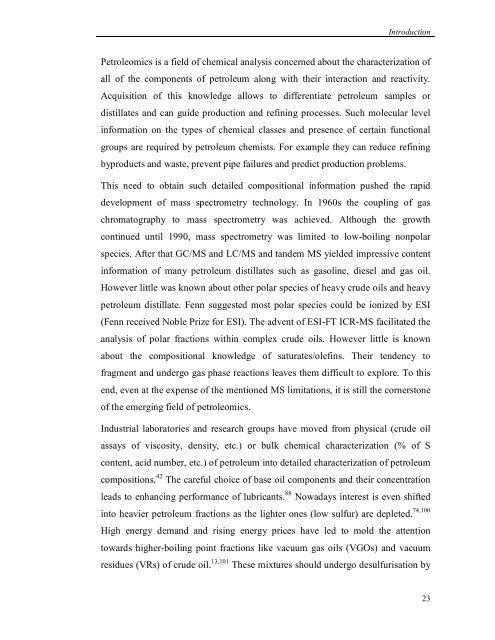Development of a Novel Mass Spectrometric ... - Jacobs University
Development of a Novel Mass Spectrometric ... - Jacobs University
Development of a Novel Mass Spectrometric ... - Jacobs University
Create successful ePaper yourself
Turn your PDF publications into a flip-book with our unique Google optimized e-Paper software.
Introduction<br />
Petroleomics is a field <strong>of</strong> chemical analysis concerned about the characterization <strong>of</strong><br />
all <strong>of</strong> the components <strong>of</strong> petroleum along with their interaction and reactivity.<br />
Acquisition <strong>of</strong> this knowledge allows to differentiate petroleum samples or<br />
distillates and can guide production and refining processes. Such molecular level<br />
information on the types <strong>of</strong> chemical classes and presence <strong>of</strong> certain functional<br />
groups are required by petroleum chemists. For example they can reduce refining<br />
byproducts and waste, prevent pipe failures and predict production problems.<br />
This need to obtain such detailed compositional information pushed the rapid<br />
development <strong>of</strong> mass spectrometry technology. In 1960s the coupling <strong>of</strong> gas<br />
chromatography to mass spectrometry was achieved. Although the growth<br />
continued until 1990, mass spectrometry was limited to low-boiling nonpolar<br />
species. After that GC/MS and LC/MS and tandem MS yielded impressive content<br />
information <strong>of</strong> many petroleum distillates such as gasoline, diesel and gas oil.<br />
However little was known about other polar species <strong>of</strong> heavy crude oils and heavy<br />
petroleum distillate. Fenn suggested most polar species could be ionized by ESI<br />
(Fenn received Noble Prize for ESI). The advent <strong>of</strong> ESI-FT ICR-MS facilitated the<br />
analysis <strong>of</strong> polar fractions within complex crude oils. However little is known<br />
about the compositional knowledge <strong>of</strong> saturates/olefins. Their tendency to<br />
fragment and undergo gas phase reactions leaves them difficult to explore. To this<br />
end, even at the expense <strong>of</strong> the mentioned MS limitations, it is still the cornerstone<br />
<strong>of</strong> the emerging field <strong>of</strong> petroleomics.<br />
Industrial laboratories and research groups have moved from physical (crude oil<br />
assays <strong>of</strong> viscosity, density, etc.) or bulk chemical characterization (% <strong>of</strong> S<br />
content, acid number, etc.) <strong>of</strong> petroleum into detailed characterization <strong>of</strong> petroleum<br />
compositions. 42 The careful choice <strong>of</strong> base oil components and their concentration<br />
leads to enhancing performance <strong>of</strong> lubricants. 88 Nowadays interest is even shifted<br />
into heavier petroleum fractions as the lighter ones (low sulfur) are depleted. 74,100<br />
High energy demand and rising energy prices have led to mold the attention<br />
towards higher-boiling point fractions like vacuum gas oils (VGOs) and vacuum<br />
residues (VRs) <strong>of</strong> crude oil. 13,101 These mixtures should undergo desulfurisation by<br />
23
















